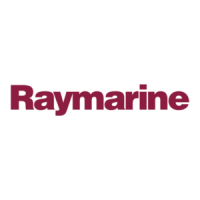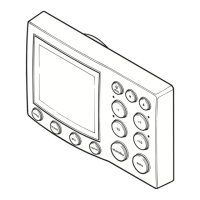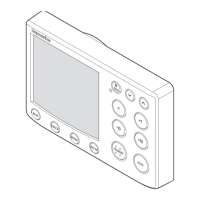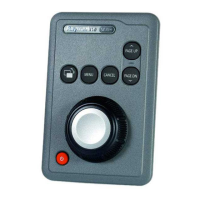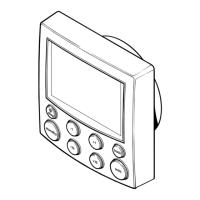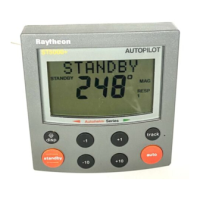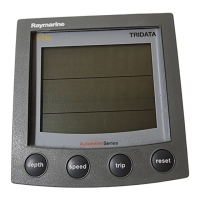Do you have a question about the Raymarine ST7000+ and is the answer not in the manual?
Explains how the handbook is divided into chapters for operation and installation.
Details verifying ownership and completing the warranty card for benefits.
Introduces the ST7000 Plus, its features, operating modes, and compatible systems.
Lists the technical specifications of the ST7000 Plus, including power, temperature, and connectivity.
Details the main single and dual key functions for controlling the autopilot via push-button operations.
Illustrates and describes all elements of the ST7000 Plus control unit LCD display.
Explains how distance units (nm, SM, km) are displayed.
Describes the initial mode and display when the ST7000 Plus is first switched on.
Provides safety guidance and steps for engaging the autopilot in Auto mode.
Explains how to disengage the autopilot and return to manual steering via the standby function.
Details two methods for changing the autopilot's course using dedicated keys.
Instructs on how to make course changes to avoid obstacles while in Auto mode.
Explains how to recall the most recent locked heading for returning to a previous course.
Describes the automatic tack facility for turning the vessel through a predetermined angle.
Explains the conditions that trigger the off course alarm and how to cancel it.
Provides advice on making course changes and handling sailboats in gusty conditions.
Explains how the ST7000 Plus enters Manual mode when a joystick is used.
Guides on adjusting the backlighting level and display contrast for optimal visibility.
Details how to set the display contrast.
Details how to cycle through and use Data Pages to display SeaTalk or NMEA data.
Explains how waypoint names are displayed on various data pages.
Describes how to use the ST7000 Plus to control ST60/ST80 instruments.
Explains how to maintain a track between waypoints using GPS, Decca, or Loran navigation.
Describes the two methods, automatic and manual, for acquiring a track.
Details the process for automatic track acquisition using SeaTalk or NMEA data.
Explains manual track acquisition when only cross track error data is available.
Defines Cross Track Error (XTE) and the associated alarm condition.
Explains how Track mode accounts for vessel speed and tidal streams for accurate tracking.
Describes how the autopilot advances to the next waypoint upon arrival.
Details the process when the vessel passes a target waypoint and the next target is selected.
Explains how to advance to the next waypoint before reaching the current target.
Covers the process when the waypoint advance alarm is sounding.
Explains how to perform dodge manoeuvres in Track mode.
Details how to maintain a course relative to an apparent wind angle using wind trim.
Guides on how to select Wind mode from Standby or Auto modes.
Explains how to adjust the locked apparent wind angle using course change keys.
Explains how to recall the previously locked apparent wind angle.
Explains how to perform dodge manoeuvres in Wind mode.
Details the wind shift alarm and how to respond to it.
Explains the automatic tack function when operating in Wind mode.
Provides tips for major course changes and sailing in gusty/unsteady conditions.
Covers adjusting response level and rudder gain for optimal autopilot performance.
Guides on how to change the autopilot's response level for course keeping accuracy.
Explains how to adjust the rudder gain for proper steering performance.
Summarizes the various alarms reported by the ST7000 Plus and how to clear them.
Describes the silent alarm indicating SeaTalk bus issues.
Explains the silent alarm for a faulty autopilot or disconnection.
Details the alarm when the vessel deviates from the locked heading.
Describes the alarm for significant changes in apparent wind angle.
Explains the alarm when cross track error exceeds a threshold.
Details the alarm when the autopilot cannot turn the rudder.
Explains alarms when navigation or wind data is not received.
Covers the alarm and process for advancing to the next waypoint.
Describes the alarm when the supply voltage drops below acceptable limits.
Explains the activation and control of the Watch alarm.
Indicates when the last waypoint of a route has been reached.
Provides emergency manual override for cable-operated sterndrive actuators.
Details the alarm when water depth is less than a defined shallow value.
Explains how MOB messages are displayed and affect waypoint data.
Notes about performing post-installation procedures before calibration and disabling pop-up pilot.
Guides on accessing and performing user-level setup for pilot type, compass, and display features.
Explains how to define the autopilot configuration based on vessel type.
Details the procedure to correct the compass for deviating magnetic fields.
Shows the calculated deviation value from the correction procedure.
Guides on adjusting heading alignment to match a known heading or transit bearing.
Allows selection between magnetic or true heading display.
Allows selection of the type of bar graph displayed at the bottom of the screen.
Explains the dockside rudder calibration procedure for helm drive systems.
Sets the duration for autopilot mode pages to pop up when Data Pages are displayed.
Explains setting the default auto tack angle for compatible course computers.
Details how to change default settings for Data Pages displayed via the 'disp' key.
Explains how to check the software versions of the ST7000 Plus and course computer.
Guides on entering Dealer Setup to customise autopilot settings for the boat.
Details calibration settings for different vessel types and initial sea trials.
Sets the pilot type, influencing default settings for other Dealer Setup options.
Controls access to User Setup, intended for charter boat users.
Explains how to set Rudder Gain, crucial for performance, especially on high-speed craft.
Adjusts rudder application to reduce course change rate.
Details setting the helm to a central position using a rudder reference unit.
Restricts autopilot rudder movement to prevent steering system overload.
Limits the rate of turn during autopilot course changes.
Sets the boat's normal cruising speed for autopilot calculations.
Configures the alarm that warns if the autopilot strays off course.
Determines the rate at which the autopilot applies "standing helm" for trim changes.
Selects the Joystick mode of operation: Proportional or 'Bang-Bang'.
Controls how the autopilot drives the steering system.
Adjusts damping to prevent drive hunting when positioning the rudder.
Sets the magnetic variation value for the vessel's current position.
Compensates for heading errors at higher latitudes due to Earth's magnetic field dip.
Used with AutoAdapt to set the vessel's current latitude.
Varies the autopilot's response when operating in Wind mode.
Provides emergency manual override for cable-operated sterndrive actuators.
Sets the power-on response level, adjustable during normal operation.
Explains using the ST7000 Plus to control ST60/ST80 instruments.
Details allocating groups of instruments to remote control keypads like the ST7000 Plus.
Guides on creating up to eight standard and eight Maxiview instrument groups.
Explains the key functions for setting up ST60/ST80 standard instrument groups.
Explains the key functions for setting up Maxiview instrument groups.
Guides on deciding unit site and cable routing before installation.
Provides guidelines to ensure performance is not compromised by electromagnetic interference.
Covers instrument installation details, including siting and mounting.
Provides cautions and requirements for positioning the instrument for protection and accessibility.
Details the step-by-step procedure for mounting the instrument, including drilling and fixing.
Explains how power should be supplied to the ST7000 Plus.
Details the standard and available SeaTalk cables for connection.
Details the standard and available SeaTalk cables for connection.
Illustrates the different types of SeaTalk cables available.
Explains how the ST7000 Plus accepts NMEA navigation data.
Advises on connecting the NMEA port to a navigator or wind instrument.
Details the use of spade connectors for NMEA connections and proper fitting.
Lists the NMEA 0183 data formats that the ST7000 Plus can decode.
Explains how NMEA data is transmitted onto SeaTalk for other instruments.
Outlines functional tests for a ST7000 Plus installed as a repeater unit.
Guides on switching on the ST7000 Plus and checking its initial operation.
Outlines checking the navigator interface via Data Pages, troubleshooting dashes.
Details how to check the SeaTalk link with other instruments.
Provides simple tests to confirm wiring and initial setup of the system.
Guides on switching on the system and checking for initial display and beeps.
Instructs on setting up the correct Pilot Type as described in Chapter 4.
Explains how to check and set the direction of helm application for course changes.
Outlines checking the navigator interface via Data Pages, troubleshooting dashes.
Details checking the link between ST7000 Plus and a wind instrument.
Details how to check the SeaTalk link to other instruments.
Discusses factors affecting product operation and checking installation before sea use.
Outlines procedures for a short sea trial to complete setup and fine-tune performance.
Details the essential procedure to correct compass errors due to magnetic fields.
Explains how to make further adjustments to heading alignment after initial correction.
Recommends a procedure to familiarise with autopilot operation after calibration.
Details tests to determine if rudder gain is set too high or too low.
Provides general advice on cleaning the unit and checking cabling.
Emphasizes that servicing should only be done by authorized personnel and highlights safety precautions.
Directs users on how to contact for product support and what information to provide.
Troubleshooting steps for when the autopilot display is blank, checking power.
Guidance for when the displayed compass heading mismatches the ship's compass, suggesting deviation correction.
Troubleshooting for slow vessel turns, suggesting low rudder gain.
Troubleshooting for overshooting turns, suggesting high rudder gain.
Troubleshooting unstable performance in Track mode, suggesting cruise speed adjustment.
Troubleshooting instability on specific headings, suggesting heading correction setup.
Explains CAL LOCK display meaning calibration protection is active.
Troubleshooting SeaTalk communication issues, suggesting cable checks.
Troubleshooting when position data is not received from the navigator.
Troubleshooting auto waypoint advance failure, noting bearing to waypoint data.
Explains rotating dashes during calibration processes.
Troubleshooting stationary dashes indicating no data received.
Troubleshooting NO DATA display, suggesting weak navigator signals.
Explains how the handbook is divided into chapters for operation and installation.
Details verifying ownership and completing the warranty card for benefits.
Introduces the ST7000 Plus, its features, operating modes, and compatible systems.
Lists the technical specifications of the ST7000 Plus, including power, temperature, and connectivity.
Details the main single and dual key functions for controlling the autopilot via push-button operations.
Illustrates and describes all elements of the ST7000 Plus control unit LCD display.
Explains how distance units (nm, SM, km) are displayed.
Describes the initial mode and display when the ST7000 Plus is first switched on.
Provides safety guidance and steps for engaging the autopilot in Auto mode.
Explains how to disengage the autopilot and return to manual steering via the standby function.
Details two methods for changing the autopilot's course using dedicated keys.
Instructs on how to make course changes to avoid obstacles while in Auto mode.
Explains how to recall the most recent locked heading for returning to a previous course.
Describes the automatic tack facility for turning the vessel through a predetermined angle.
Explains the conditions that trigger the off course alarm and how to cancel it.
Provides advice on making course changes and handling sailboats in gusty conditions.
Explains how the ST7000 Plus enters Manual mode when a joystick is used.
Guides on adjusting the backlighting level and display contrast for optimal visibility.
Details how to set the display contrast.
Details how to cycle through and use Data Pages to display SeaTalk or NMEA data.
Explains how waypoint names are displayed on various data pages.
Describes how to use the ST7000 Plus to control ST60/ST80 instruments.
Explains how to maintain a track between waypoints using GPS, Decca, or Loran navigation.
Describes the two methods, automatic and manual, for acquiring a track.
Details the process for automatic track acquisition using SeaTalk or NMEA data.
Explains manual track acquisition when only cross track error data is available.
Defines Cross Track Error (XTE) and the associated alarm condition.
Explains how Track mode accounts for vessel speed and tidal streams for accurate tracking.
Describes how the autopilot advances to the next waypoint upon arrival.
Details the process when the vessel passes a target waypoint and the next target is selected.
Explains how to advance to the next waypoint before reaching the current target.
Covers the process when the waypoint advance alarm is sounding.
Explains how to perform dodge manoeuvres in Track mode.
Details how to maintain a course relative to an apparent wind angle using wind trim.
Guides on how to select Wind mode from Standby or Auto modes.
Explains how to adjust the locked apparent wind angle using course change keys.
Explains how to recall the previously locked apparent wind angle.
Explains how to perform dodge manoeuvres in Wind mode.
Details the wind shift alarm and how to respond to it.
Explains the automatic tack function when operating in Wind mode.
Provides tips for major course changes and sailing in gusty/unsteady conditions.
Covers adjusting response level and rudder gain for optimal autopilot performance.
Guides on how to change the autopilot's response level for course keeping accuracy.
Explains how to adjust the rudder gain for proper steering performance.
Summarizes the various alarms reported by the ST7000 Plus and how to clear them.
Describes the silent alarm indicating SeaTalk bus issues.
Explains the silent alarm for a faulty autopilot or disconnection.
Details the alarm when the vessel deviates from the locked heading.
Describes the alarm for significant changes in apparent wind angle.
Explains the alarm when cross track error exceeds a threshold.
Details the alarm when the autopilot cannot turn the rudder.
Explains alarms when navigation or wind data is not received.
Covers the alarm and process for advancing to the next waypoint.
Describes the alarm when the supply voltage drops below acceptable limits.
Explains the activation and control of the Watch alarm.
Indicates when the last waypoint of a route has been reached.
Provides emergency manual override for cable-operated sterndrive actuators.
Details the alarm when water depth is less than a defined shallow value.
Explains how MOB messages are displayed and affect waypoint data.
Notes about performing post-installation procedures before calibration and disabling pop-up pilot.
Guides on accessing and performing user-level setup for pilot type, compass, and display features.
Explains how to define the autopilot configuration based on vessel type.
Details the procedure to correct the compass for deviating magnetic fields.
Shows the calculated deviation value from the correction procedure.
Guides on adjusting heading alignment to match a known heading or transit bearing.
Allows selection between magnetic or true heading display.
Allows selection of the type of bar graph displayed at the bottom of the screen.
Explains the dockside rudder calibration procedure for helm drive systems.
Sets the duration for autopilot mode pages to pop up when Data Pages are displayed.
Explains setting the default auto tack angle for compatible course computers.
Details how to change default settings for Data Pages displayed via the 'disp' key.
Explains how to check the software versions of the ST7000 Plus and course computer.
Guides on entering Dealer Setup to customise autopilot settings for the boat.
Details calibration settings for different vessel types and initial sea trials.
Sets the pilot type, influencing default settings for other Dealer Setup options.
Controls access to User Setup, intended for charter boat users.
Explains how to set Rudder Gain, crucial for performance, especially on high-speed craft.
Adjusts rudder application to reduce course change rate.
Details setting the helm to a central position using a rudder reference unit.
Restricts autopilot rudder movement to prevent steering system overload.
Limits the rate of turn during autopilot course changes.
Sets the boat's normal cruising speed for autopilot calculations.
Configures the alarm that warns if the autopilot strays off course.
Determines the rate at which the autopilot applies "standing helm" for trim changes.
Selects the Joystick mode of operation: Proportional or 'Bang-Bang'.
Controls how the autopilot drives the steering system.
Adjusts damping to prevent drive hunting when positioning the rudder.
Sets the magnetic variation value for the vessel's current position.
Compensates for heading errors at higher latitudes due to Earth's magnetic field dip.
Used with AutoAdapt to set the vessel's current latitude.
Varies the autopilot's response when operating in Wind mode.
Provides emergency manual override for cable-operated sterndrive actuators.
Sets the power-on response level, adjustable during normal operation.
Explains using the ST7000 Plus to control ST60/ST80 instruments.
Details allocating groups of instruments to remote control keypads like the ST7000 Plus.
Guides on creating up to eight standard and eight Maxiview instrument groups.
Explains the key functions for setting up ST60/ST80 standard instrument groups.
Explains the key functions for setting up Maxiview instrument groups.
Guides on deciding unit site and cable routing before installation.
Provides guidelines to ensure performance is not compromised by electromagnetic interference.
Covers instrument installation details, including siting and mounting.
Provides cautions and requirements for positioning the instrument for protection and accessibility.
Details the step-by-step procedure for mounting the instrument, including drilling and fixing.
Explains how power should be supplied to the ST7000 Plus.
Details the standard and available SeaTalk cables for connection.
Details the standard and available SeaTalk cables for connection.
Illustrates the different types of SeaTalk cables available.
Explains how the ST7000 Plus accepts NMEA navigation data.
Advises on connecting the NMEA port to a navigator or wind instrument.
Details the use of spade connectors for NMEA connections and proper fitting.
Lists the NMEA 0183 data formats that the ST7000 Plus can decode.
Explains how NMEA data is transmitted onto SeaTalk for other instruments.
Outlines functional tests for a ST7000 Plus installed as a repeater unit.
Guides on switching on the ST7000 Plus and checking its initial operation.
Outlines checking the navigator interface via Data Pages, troubleshooting dashes.
Details how to check the SeaTalk link with other instruments.
Provides simple tests to confirm wiring and initial setup of the system.
Guides on switching on the system and checking for initial display and beeps.
Instructs on setting up the correct Pilot Type as described in Chapter 4.
Explains how to check and set the direction of helm application for course changes.
Outlines checking the navigator interface via Data Pages, troubleshooting dashes.
Details checking the link between ST7000 Plus and a wind instrument.
Details how to check the SeaTalk link to other instruments.
Discusses factors affecting product operation and checking installation before sea use.
Outlines procedures for a short sea trial to complete setup and fine-tune performance.
Details the essential procedure to correct compass errors due to magnetic fields.
Explains how to make further adjustments to heading alignment after initial correction.
Recommends a procedure to familiarise with autopilot operation after calibration.
Details tests to determine if rudder gain is set too high or too low.
Provides general advice on cleaning the unit and checking cabling.
Emphasizes that servicing should only be done by authorized personnel and highlights safety precautions.
Directs users on how to contact for product support and what information to provide.
Troubleshooting steps for when the autopilot display is blank, checking power.
Guidance for when the displayed compass heading mismatches the ship's compass, suggesting deviation correction.
Troubleshooting for slow vessel turns, suggesting low rudder gain.
Troubleshooting for overshooting turns, suggesting high rudder gain.
Troubleshooting unstable performance in Track mode, suggesting cruise speed adjustment.
Troubleshooting instability on specific headings, suggesting heading correction setup.
Explains CAL LOCK display meaning calibration protection is active.
Troubleshooting SeaTalk communication issues, suggesting cable checks.
Troubleshooting when position data is not received from the navigator.
Troubleshooting auto waypoint advance failure, noting bearing to waypoint data.
Explains rotating dashes during calibration processes.
Troubleshooting stationary dashes indicating no data received.
Troubleshooting NO DATA display, suggesting weak navigator signals.
| Brand | Raymarine |
|---|---|
| Model | ST7000+ |
| Category | Marine Equipment |
| Language | English |
